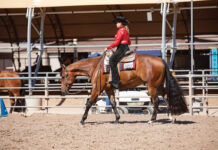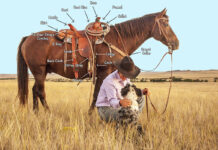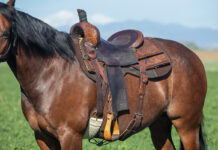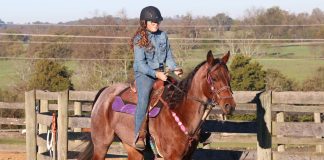Few things are more annoying than a horse that tosses his head under saddle. It’s hard to focus or get your horse to pay attention, and an irritated horse can’t do his job well. Frustrated with your horse’s head-tossing? AQHA Professional Horseman Allen Walton has a few ideas on how to fix the problem that he says stems from two main sources: discomfort or anxiety.
Cause for Head Tossing: Physical issues
How to handle it:
Your first line of defense is an appointment with your veterinarian to rule out mouth or ear issues, or any other physical problem.
Cause for Head Tossing: Equipment
Poorly fitting tack, particularly your bit or bridle, is a sure-fire way to induce head tossing, according to Walton.
Horses look for comfort, so if there’s something bothering them—equipment that doesn’t fit, isn’t adjusted properly, or maybe is too severe—that could create a head tossing problem, he says.
How to handle it:
Go over your equipment carefully. If you’re not sure that it fits correctly, ask a professional for help. Allen says a twisted curb chain or a strap that’s stiff or in the wrong place can cause discomfort; so can a curb strap that is improperly adjusted.
“A curb strap in the wrong spot can pinch the horse’s lips every time you pull on the reins,” says Walton.
Cause for Head Tossing: Poor Riding Technique
If you’ve ruled out medical issues and equipment as the culprit, Walton says it’s time to take a look at your riding.
“Are you handling your horse with a soft feel, or are you too quick with your hands?” he says. “A quick, sharp cue creates discomfort for your horse, and if he’s responding by tossing and shaking his head, there’s something bothering him. Be a detective and figure it out.”
How to handle it:
Evaluate how you’re cueing your horse. If you find yourself snatching at your horse’s mouth or moving your hand too quickly, work to train your mind to slow your cues. Think about gradually taking the slack out of your reins to establish contact before asking your horse to respond.
“Work on seeing how little pressure you can use to get a response from your horse,” says Walton. “You can’t be quick with your hand. You need to be soft and reassuring to develop the right kind of communication.”
Consistency is another element you need to master to calm head tossing, according to Walton.
“When you’re inconsistent with your cues, or with your hands, your horse loses confidence in what you’re doing, and he’s always trying to be comfortable,” he says. “When he’s trying to find a comfortable place in that situation, he can wind up tossing his head.”

The level of contact you have depends on many factors; riding a colt for the first few times requires different contact than riding a horse more advanced in his training. How much experience your horse has had, and if that experience is good or bad, all weighs in on how to approach your cues.
“It’s all relevant, but the big thing is you need to be consistent with your cues,” says Walton. “No matter what, you want to develop a soft feel. Don’t pull hard one second, then use loose reins and suddenly take the slack out of them. When the horse gets comfortable, quit for the day.”
Cause for Head Tossing: Fresh Horse
If your horse is kept in a stall or a small pen, especially if he’s fed a high-energy diet, Walton says this could cause a horse to act out by tossing his head.
“They can get pretty silly, shaking their head and throwing it, if they have too much energy,” he says. “He probably doesn’t really have a head tossing problem at that point, but he will if it’s not handled properly.”
How to handle it:
Allen recommends turning your horse out for two or three hours a day so he can get plenty of exercise before you ride.
Meet the Expert
Allen Walton is an AQHA Professional Horseman located in Bluff Dale, Texas, with his wife, Bobbie, who is the director at Tarleton State University Equine Center.
Well-versed in many events, Allen focuses on training and riding in cutting, reining, reined cow horse, roping and ranch and stock horse classes. He’s competed at events such as the National Cutting Horse Association Futurity, the American Quarter Horse Association World Show the World’s Greatest Horseman competition and Senior Steer Roping Finals. Allen hold judge’s cards for AQHA, American Paint Horse Association and National Reined Cow Horse Association. He’s judged the AQHA World Show several times, as well as the AQHA Versatility Ranch Horse World Show and Stock Horse of Texas Championships and the American Stock Horse Association National Championship.
This article originally appeared in the May 2019 issue of Horse Illustrated magazine. Click here to subscribe!





